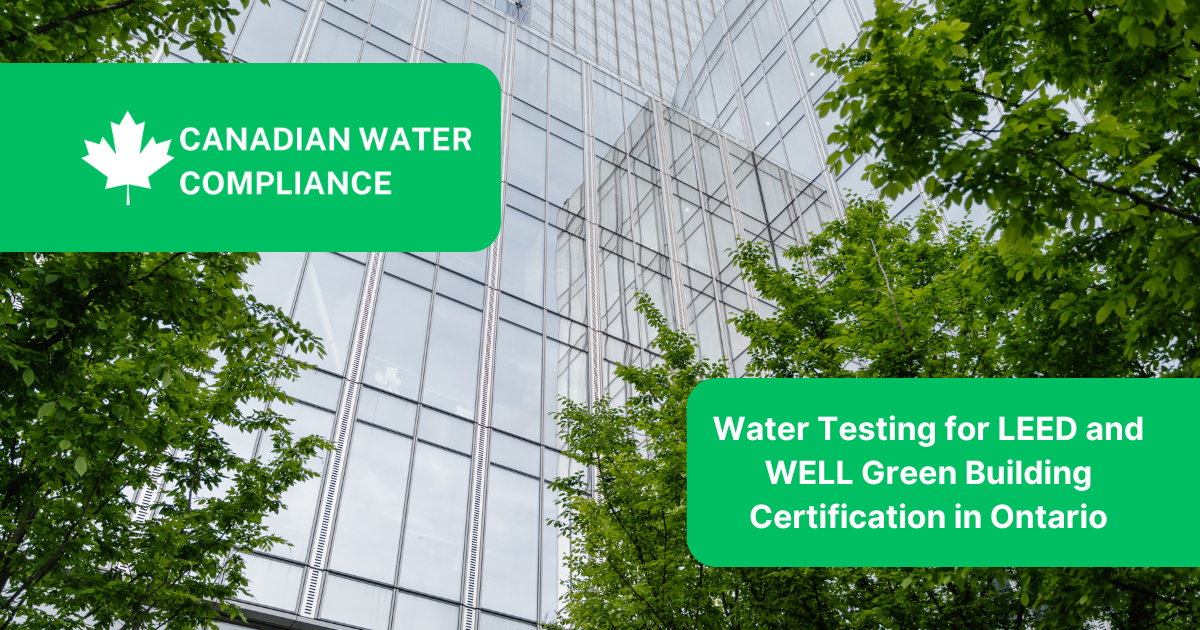
Written By: Canadian Water Compliance | On
As Ontario’s construction industry shifts toward sustainable design and healthier buildings, water quality testing is playing a vital—yet often overlooked—role in achieving green building certifications like LEED (Leadership in Energy and Environmental Design) and WELL Building Standard. These globally recognized frameworks increasingly emphasize not only energy efficiency and materials but also the safety, health, and sustainability of water systems.
Whether you're working on a new high-rise in Toronto, a LEED-certified school renovation in Hamilton, or a WELL-certified office in Ottawa, understanding the water testing requirements of these programs is essential to meeting certification goals and protecting occupant health.
Green building programs prioritize indoor environmental quality, and water is a key component of that. Inadequate testing or failure to meet performance benchmarks can derail certification efforts or result in costly retrofits.
Water quality testing supports:
Occupant health and safety: Detecting harmful contaminants like lead, bacteria, and VOCs
System sustainability: Preventing scale, corrosion, and premature HVAC/plumbing failure
Certification compliance: Meeting performance thresholds for LEED v4, WELL v2, Fitwel, and others
LEED focuses on water efficiency, human health, and infrastructure resilience. While not all credits mandate testing, several relate directly to water quality:
LEED v4 Indoor Environmental Quality (EQ) Credit – Enhanced IAQ Strategies
Requires water testing if humidification or misting systems are in use.
Encourages testing for contaminants where water aerosolization occurs.
LEED v4 Water Efficiency Credit – Cooling Tower Water Management
Calls for monitoring cycles of concentration, biological growth, and corrosion.
Innovation Credit Opportunities
Projects may earn points for going above code with proactive Legionella or potable water testing.
The WELL Building Standard places water front and centre. It sets strict quality criteria for drinking water, targeting both chemical and microbiological contaminants.
WELL v2 Water Concept requires:
Annual laboratory testing for:
E. coli and Total Coliforms
Lead, copper, nitrate, nitrite, and disinfection by-products
Turbidity, total dissolved solids (TDS), pH, and chlorine residual
Action plans when results exceed thresholds
Filtration systems or engineering controls based on risk assessments
WELL also rewards points for real-time monitoring, Legionella risk management, and proactive plumbing maintenance—all of which benefit from third-party water testing.
Depending on the certification pursued, common parameters include:
Microbiological: E. coli, Total Coliforms, Legionella
Metals: Lead, Copper, Iron, Manganese
Disinfection by-products: Trihalomethanes (THMs), Haloacetic acids (HAAs)
Chemical & physical: pH, chlorine, TDS, turbidity, hardness
These parameters must meet thresholds based on Health Canada’s Guidelines for Canadian Drinking Water Quality or other referenced standards.
Our services help architects, engineers, sustainability consultants, and building owners meet LEED, WELL, and other certification requirements with ease:
Certified sampling and lab analysis for all required parameters
Custom water testing packages aligned with your project goals
Legionella risk assessments and flushing protocols
Documentation support for project submission and inspection
We provide end-to-end support for construction, commissioning, and ongoing building operation—ensuring your water systems are clean, compliant, and certification-ready.